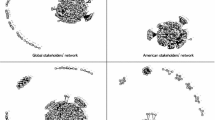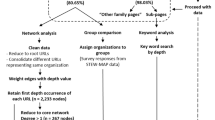Abstract
This study investigates corporate relationships with environmental organizations by examining hyperlinks in the corporate environmental responsibility (CER) sections of the Fortune 2008 Global 500 corporate websites. It is assumed that hyperlinked organizations either represent their current inter-organizational relationship or create symbolic relationships among organizations. Results show that Asian companies have fewer hyperlink relations with other organizations compared with those in North America and Western Europe. Network analysis also confirms that U.S. companies are explicitly connected with stakeholders for CER practices, and governmental organizations have a relatively central role in the global CER system. Nonprofit organizations are the most frequently hyperlinked with Fortune Global 500 corporations.
Similar content being viewed by others
Abbreviations
- CSR:
-
Corporate social responsibility
- CER:
-
Corporate environmental responsibility
- NPO:
-
Nonprofit organization
- IGO:
-
Intergovernmental organization
References
Alsop, R. J. (2004). The 18 immutable laws of corporate reputation. New York, NY: Free Press.
Bach, J., & Stark, D. (2004). Link, search, interact: The co-evolution of NGOs and interactive technology. Theory, culture, and Society, 21(3), 101–117.
Barnett, G. A., & Sung, E. (2005). Culture and the structure of the international hyperlink network. Journal of Computer Mediated Communication 11(5). Available at: http://jcmc.indiana.edu/vol11/issue1/barnett.html. Accessed 21 July 2010 (online).
Biermann, J. S., Golladay, G. J., et al. (1999). Evaluation of cancer information of the internet. Cancer, 86, 381–390.
Bondy, K., Matten, D., et al. (2004). The adoption of voluntary codes of conduct in MNCs: A three-country comparative study. Business and Society Review, 109(4), 449–477.
Borgatti, S. P., Everett, M. H., et al. (2002). UCINET for windows: Software for social network analysis version 6. Harvard, MA: Analytic Technologies.
Brammer, S., & Pavelin, S. (2005). Corporate community contributions in the United Kingdom and the United States. Journal of Business Ethics, 56, 15–26.
Brunn, S. D., & Dodge, M. (2001). Mapping the worlds of the world wide web: (Re)Structuring global commerce through hyperlinks. American Behavioral Scientist, 44(10), 1717–1739.
Capriotti, P., & Moreno, A. (2007). Corporate citizenship and public relations: The importance and interactivity of social responsibility issues on corporate websites. Public Relation Review, 33, 84–91.
Chapple, W., & Moon, J. (2005). Corporate social responsibility in Asia: A seven country study of CSR website reporting. Business and Society, 44, 415–441.
Cummings, J. L., & Doh, J. P. (2000). Identifying who matters: Mapping key players in multiple environment. California Management Review, 42(2), 83–104.
Doh, J. P., & Guay, T. R. (2006). Corporate Social Responsibility, Public Policy, and NGO activism in Europe and the United States: An institutional-stakeholder perspective. Journal of Management Studies, 43(1), 47–73.
Doh, J. P., & Teegen, H. (2002). Nongovernmental organizations as institutional actors in international business: Theory and implications. International Business Review, 11, 665–684.
Donaldson, T., & Preston, L. E. (1995). The stakeholder theory of the corporation: Concepts, evidence, and implications. Academy of Management, 20, 65–91.
Esrock, S., & Leichty, G. (1998). Social responsibility and corporate web pages: Self-presentation or agenda-setting? Public Relations Review, 24(3), 305–319.
Esrock, S. L., & Leighty, G. B. (2000). Organization of corporate web pages: Publics and functions. Public Relations Review, 26(3), 327–344.
Eweje, G. (2007). Strategic partnership between MNEs and civil society: The post WSSD perspectives. Sustainable Development Journal, 15, 15–27.
Eweje, G., & Palakshappa, N. (2009). Business partnership with nonprofits: Working to solve mutual problems in New Zealand. Corporate Social Responsibility and Environmental Management, 16, 337–351.
Fowler, P., & Heap, S. (2000). Bridging troubled waters: The marine stewardship council. In J. Bendell (Ed.), Terms for endearment: Business, NGOs and sustainable development (pp. 135–148). Sheffield, UK: Greenleaf Publishing Ltd.
Freeman, R. E. (1984). Strategic management: A stakeholder approach. Boston: Pitman Publishing.
Freeman, E., & Reed, D. (1983). Stockholders and stakeholders: A new perspective on corporate governance. In C. Huizinga (Ed.), Corporate governance: A definitive exploration of the issues. Los Angeles, CA: UCLA Extension Press.
Galbreath, J. (2006). Does primary stakeholder management positively affect the bottom line? Some Evidence from Australia. Management Decision, 44(8), 1106–1121.
Garrido, M., & Halavais, A. (2003). Mapping networks of support for the Zapatista movement: Applying social network analysis to study contemporary social movements. In M. McCaughey & M. Ayers (Eds.), Cyberactivism: Online activism in theory and practice (pp. 165–184). London, UK: Routledge.
Glasbergen, P., & Groenenberg, R. (2001). Environmental partnerships in sustainable energy. European Environment, 11, 1–13.
Hanneman, R. A., & Riddle, M. (2005). Introduction to social network methods. Available at http://faculty.ucr.edu/~hanneman/. Accessed 18 June 2009 (online).
Hill, L., & White, C. (2000). Public relations practitioners’ perception of the world wide web as a communications tool. Public Relations Review, 26(1), 31–51.
Ingenhoff, D., & Koelling, A. M. (2008). The potential of websites as a relationship building tool for charitable fundraising NPOs. Public Relations Review, 35, 66–73.
Jackson, M. H. (1997). Assessing the structure of communication on the world wide web. Journal of Computer Mediated Communication 3(1). Available at http://www.ascusc.org/jcmc/vol3/issue1/jackson.htm. Accessed 12 June 2009 (online).
Kent, M., & Taylor, M. (1998). Building dialogic relationships through the world wide web. Public Relations Review, 24(3), 321–334.
Kent, M., Taylor, M., et al. (2003). The relationship between web site design and organization responsiveness to stakeholders. Public Relations Review, 29, 63–77.
Kim, D., Nam, Y., et al. (2010). An analysis of corporate environmental responsibility on the global companies’ websites and their dialogic principles. Public Relation Review, 36(3), 285–288.
Kleinberg, J. M. (1999). Hubs, authorities, and communities. ACM Computing Surveys 31(4). Available at http://www.cs.brown.edu/memex/ACM_HypertextTestbed/papers/10.html. Accessed 23 June 2009 (online).
Krackhardt, D., & Porter, L. (1986). The snowball effect: Turnover embedded in communication networks. Journal of Applied Psychology, 71, 50–55.
Lister, S. (2003). NGO legitimacy: Technical issue or social construct? Critique of Anthropology, 2, 175–191.
Livesey, S. (1999). McDonald’s execs explore makeover for Ronald icon. Advertising Age, 70(34), 14–18.
Maignan, I., & Ralston, D. A. (2002). Corporate social responsibility in Europe and the U.S.: Insights from businesses’ self-presentations. Journal of International Business Studies, 33, 497–515.
Marcus, A., Geffen, D., et al. (2002). Reinventing environmental regulation: Lessons from Projecct XL. Washington, D.C.: Resources for the Future.
Matten, D., & Moon, J. (2008). “Implicit” and “explicit” CSR: A conceptual framework for a comparative understanding of corporate social responsibility. Academy of Management Review, 33(2), 404–424.
Millar, C. C. J. M., Choi, C. J., et al. (2004). Global strategic partnerships between MNEs and NGOs: Drivers of change and ethical issues. Business and Society Review, 109(4), 395–414.
Milliman, J., & Grosskopf, J. (2001). Enhancing environmental business and leadership skills: Environmental dialogue sessions for EHandS professionals. Corporate Environmental Strategy 8(3), 209–216.
O’Neill, K. (1999). Internetworking for social change: Keeping the spotlight on corporate responsibility. Geneva, Switzerland: United Nations research institute for social development.
Ossewaarde, M., Nijhof, A., et al. (2008). Dynamics of NGO legitimacy: How organizing betrays core missions of iNGOs. Public Administration and Development, 28, 42–53.
Park, H. W. (2003). Hyperlink network analysis: A new method for the study of social structure on the web. Connections, 25, 49–61.
Park, H. W., Barnett, G. A., et al. (2002). Hyperlink-affiliation network structure of top websites: Examining affiliates with hyperlinks in Korea. Journal of the American Society for Information Science and Technology, 53(7), 592–601.
Park, H. W., & Thelwall M., et al. (2005). Political hyperlinking in South Korea: Technical indicators of ideology and content. Sociological Research Online 10(3), Available at http://www.socresonline.org.uk/10/3/park.html. Accessed March 21 2010 (online).
Richards, W. D., & Barnett, G. A. (1993). Progress in communication science. Norwood, NJ: Ablex.
Rogers, E. M., & Kincaid, D. L. (1981). Communication networks: Toward a new paradigm for research. New York, NY: Free Press.
Ronfeldt, D. (1999). The Zapatista social netwar in Mexico. Santa Monica, CA: Rand.
Shumate, M., & Dewitt, L. (2008). The north/south divide in NGO hyperlink networks. Journal of Computer Mediated Communication, 13, 405–428.
Smith, J. (1997). Characteristics of the modern transnational social movement sector. In J. Smith, C. Chatfield, & R. Pagnucco (Eds.), Transnational social movements and global politics: Solidarity beyond the state (pp. 42–58). Syracuse, NY: Syracuse University Press.
Stuart, H., & Jones, C. (2004). Corporate branding in marketspace. Corporate Reputation Review, 7(1), 84–98.
Sullivan, J. (1999). What are the functions of corporate home pages? Journal of World Business, 34(2), 193–210.
Thelwall, M. (2001). Commercial web site links. Internet Research. Electronic Networking Applications and Policy, 11(2), 114–124.
Thelwall, M., & Harries, G. (2004). Do better scholars’ web publications have significantly higher online impact? Journal of the American Society for Information Science and Technology, 55(2), 149–159.
UN. (1993). Handbook of national accounting: Integrated environmental and economic accounting. New York, NY: United Nations.
UNEP. (2009). 2009 Annual report: Seizing the green opportunity. Geneva: United Nations Environment Programme Publications, Available at http://www.unep.org/PDF/UNEP_AR_2009_FINAL.pdf. Accessed 23 June 2009 (online).
Vreelnad, R. (2000). Law libraries in cyberspace: A citation analysis of world wide web sites. Law library Journal, 92, 49–56.
Wanderley, L. S. O., Lucian, R., et al. (2008). CSR information disclosure on the web: A context-based approach analysing the influence of country of origin and industry sector. Journal of Business Ethics, 82, 369–378.
White, C., & Raman, N. (1999). The world wide web as a public relations medium: The use of research, planning and evaluation in web site development. Public Relations Review, 25(4), 409–419.
Author information
Authors and Affiliations
Corresponding author
Rights and permissions
About this article
Cite this article
Kim, D., Nam, Y. Corporate Relations with Environmental Organizations Represented by Hyperlinks on the Fortune Global 500 Companies’ Websites. J Bus Ethics 105, 475–487 (2012). https://doi.org/10.1007/s10551-011-0980-0
Received:
Accepted:
Published:
Issue Date:
DOI: https://doi.org/10.1007/s10551-011-0980-0




